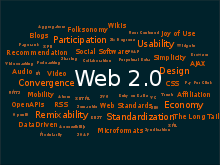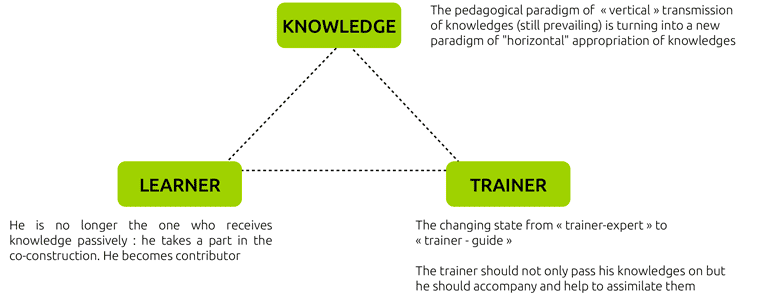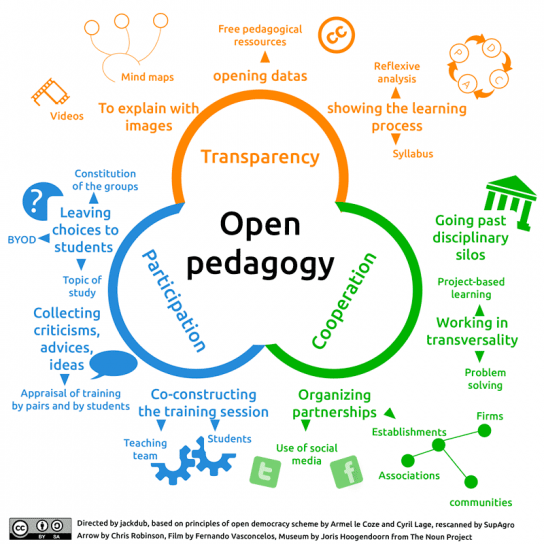Introducing the Cooptic project
Cooptic is an initiative for innovation transfer funded by the European Commission within the framework of the Leonardo da Vinci project. Four partners specializing in innovative teaching methods - Suprago Florac and Outils-Réseaux (Montpellier), the Cooperation School Aposta from Catalonia and the Regional Centre for Environmental Initiatives (CRIE Mouscron) from Wallonia – joined forces to work on adapting a training tool for collaborative project facilitators.
During the Cooptic project, fifteen people from three countries (Belgium, France and Spain) received training to become trainers of cooperative project and network facilitators, in their respective circles.
Cooptic today has 60 network facilitators forming a real pool in three European countries. This network developed over the course of three years:

Introducing the team of partners
The Cooptic programme linked four structures:


The ‘reference’ association in France for networking. Its main mission is to start and accompany cooperative networks and practices using methodological tools and the Internet. In 2010, Outils-Réseaux created the Animacoop training tool for facilitators and professionals working in the fields of cooperation and network facilitation. This Animacoop tool was a part of the European Cooptic project.


These partners brought together the skills of several institutions, universities, researchers, and local actors and groups engaging in participatory development who actively participated in drafting the e-book you have in your hands.
Introduction to the learning tool
The Cooptic learning tool is based on educational principles that aim to accompany trainees along the path to autonomy and building their capacity to carry out informed actions. Trainees are the main focus of the teaching tool. These principles lead to the choice of teaching methods and resources that are articulated around three ideas: the crosscutting nature of knowledge and collaborative skills to be learnt; a link to the professional projects of trainees; and the use of the possibilities offered by digital tools to innovate in teaching practices.What can be learnt with the Cooptic training?
The training contents favour the development of operational skills linked to the facilitation of cooperative projects: managing information, co-producing resources, starting network dynamics, group facilitation…These contents are structured around 12 key concepts and 12 crosscutting collaborative skills:

These collaborative skills are dealt with in parallel at three different levels:
- at an individual level, training develops the engagement of a person in a collaborative project,
- at a group level, training deals with understanding group dynamics, networks, groups and skills to manage a group,
- a third level relating to the environment refers to openness factors and communication “outside” the network.
How is the learning done?
During a training period of 14 weeks, trainees work remotely and on-site following a progression in three parallel itineraries:- Individual itinerary:

- Creation of the network: the group is established, a “group of individuals” becomes aware that it is a learning group.
- The network becomes informed: exchanges on the projects lead to a set of common experiences and problems.
- The network is transformed: individual and collective events are created in small-group collaborative work.
- Network outreach: spreading the outcomes of the cooperation works outside the community brings value to it.
- Network consolidation: this allows for an assessment and a reflexion on how to maintain the dynamics alive and how to open up to others.
- Collective trainee itinerary :

- Project itinerary :
A pedagogy impacted by new technologies
A training ecosystem:A methodology to move from “network facilitators” to “trainers of network facilitators”
A combination of on-site and distance exchanges using Internet-based tools
Using collaborative tools and methods during the training process.
Moments to exchange practices
Individual work on the trainees’ collaborative projects
Co-generation of knowledge: pedagogical training plans.
The Cooptic ebook
The ebook that you are handling contains the resources used during the CoopTic training session. Some were written specifically for the ebook because the contents were presented orally during training. This book is a state of our knowledge in the field of cooperation and collaboration at the time of writing in late 2013. But this is an area that is just beginning to be studied and we continue to experiment, to imagine, to try, to dream ... To make it short, even if the publication of this ebook is the outcome of the European project Leonardo CoopTic, this is not the end but just the bases of our future projects: a resource center on collaboration? A MOOC? Or perhaps something that does not exist yet!Enjoy your reading and your "small irreversible cooperation experiences" to come!
They took part in the adventure !
Coordination :
Hélène Laxenaire
Authors :
Gatien Bataille
Jean-Michel Cornu
Antoine Delarue
FNAMI LR
Mathilde Guiné
Claire Herrgott
Emilie Hullo
Corinne Lamarche
Hélène Laxenaire
Heather Marsh
Laurent Marseault
Daniel Mathieu
Outils-réseaux
Jordi Picart i Barrot
Manon Pierrel
Frédéric Renier
Violette Roche
Elzbieta Sanojca
SupAgro Florac
Vincent Tardieu
Laurent Tézenas
Françoise Viala
and the Animacoop trainees.
Drawings :
Eric Grelet
Conception of routes
Claire d'Hauteville
Hélène Laxenaire
Elzbieta Sanojca
Translation in French :
Collaborative translation by members of the group AnimFr (article about stimergy)
Translation in English :
Koinos
Suzy Lewis-Vialar
Abdel Guerdane
Translation in Catalan :
Koinos
Jordi Picart i Barrot
Proofreading (of the French part) :
Caroline Seguin
Standardization of texts :
Cathy Azema
Gatien Bataille
David Delon
Corinne Lamarche
Hélène Laxenaire
Christian Resche
Cécile Trédaniel
Development:
Florian Schmitt
Graphic standards :
Imago design
Settlement and monitoring of the Leonardo project
Guy Levêque
Cathy Azema
Martine Pedulla
Stéphanie Guinard
This work was achieved within the framework of a project of transfer of innovation (TOI) funded by the European Union through the Leonardo Da Vinci program.
All the contents (texts, images, videos) are under Creative Commons BY-SA 3.0 FR license. This means that you can freely distribute, modify and use them in a commercial context. You have two obligations: quote the original authors and the content that you create from ours should be shared in the same conditions under CC-BY-SA .
Animation of collaborative tools : restraints and enablers.
Card's author :
Outils-réseaux
Card's type of licence :
Creative Commons BY-SA
Description :


What restrains
- Lack of participation
- At tools level
- At facilitator's level
- At project level
- Lack of time
What enables
- At people's level
- At tools level
- At organisation level
- At projects level
- The 9 laws of cooperation
A pad for a rural accommodation. What for?
Card's author :
Corinne Lamarche - SupAgro Florac
Card's type of licence :
Creative Commons BY-SA
Testimonies :
Creating a pad in an association
Art students creating a wiki book
Card's author :
Stephan Barron
Card's type of licence :
Creative Commons BY-SA
Testimonies :
Stéphan Barron set up a collaborative space for his art students. This space is a wiki. He is a teacher and researcher at the Paul-Valéry University, Montpellier III.
Why do this?
- for a space to submit papers and homework,
- for a space to find information, create, and share documents ...
- for collective creation of contents
- for a space for information on pedagogy, professional careers, exhibitions…

A taste of OpenStreetMap, technical skills and a lot of patience for a citizen mapping and the valuing of scrubland heritage
Card's author :
Manon Pierrel - Association Collectif des Garrigues
Card's type of licence :
Creative Commons BY-SA
Testimonies :
Members of the Collectif des Garrigues managed to converge two of their projects which, at first sight, seemed far apart. One project was on participatory mapping, requiring some technical skills, internet tools…and a project to learn about and value the scrubland heritage lead by people who are passionate about history, books and the scrublands…These two "groups" met within the Collectif des Garrigues to set up a lovely collective project, rich in knowledge and innovative! The main goal of this project is to contribute to the dynamics of the network between the actors in the scrublands by co-drawing interactive maps (with collective contributions) as a support to show the rich heritage in the area, to share knowledge and to bring value into the scrubland territory.
Since 2010, several works have been developed, such as:
The network members who participate in all these work areas have spaces on the Internet (wikis) to work on and produce content together and at a distance. They have discussion lists, co-writing tools (Etherpad) and "software" that allows them to organise their work (face-to-face for logistics or the distribution of work) and tools to disseminate their work. Many of these work areas perform very well, make rapid progress, and some are even at the stage of completion (especially the Atlas) while new projects are created almost every month. The network members develop the work areas themselves and facilitate participation in the different work pillars. Once the first productions are ready, works are assessed and disseminated at large, especially though their monthly newsletter and the website of the Collectivité des Garrigues, wikigarrigue.info. This way of working makes members want to continue working together to develop some projects in greater depth...and this creates an even greater convergence of work areas and the establishment of new ones. The proof is in the pudding!
How did the members of the Collectif des Garrigues work to get these two work areas to progress independently? How were they linked further on?
The theme knowledge on "heritage" gained momentum in 2011 with the organising of the Rendez-vous des Garrigues (Scrubland Excursions) on this theme. Dry-stone heritage is particularly an identity feature of the scrublands and the structures (associations or groups) in charge of bringing value to and restoring this heritage on a local level often face the same problems in all scrubland territories. That is why they needed to meet and take some time to think collectively so they could advance collectively in some projects.
After this Scrubland Excursion, some concrete actions were put in place:
In the autumn of 2012, with all the exchanges on the list, a second Scrubland Excursion was organised on this theme. That is when the idea emerged of creating a directory of directories of all the dry-stone cabins in the scrubland territories to end up with a map of the areas with these constructions (400,000 Ha.)
One of the members of the heritage group decided to be in charge of the project.
This training session took place in Gignac (34) in April 2012, and was followed by a carto-party on site to continue attracting people. The idea for each of these stages was to learn about the data collected and how to put them on-line to gradually specialise in mapping elements that were of our interest (especially heritage). At each carto-party we were able to attract new people.
Since the spring of 2012 a healthy group of around forty have continued with the project "cartogarrigue". They have a simple discussion list to exchange and work together which is extremely active and reactive, and convivial with the help of the Collectif des Garrigues network that helps with the organisation and logistics.
In a first stage, the group "cartogarrigue" took some time to learn to use the tool and to build a common discourse. Then it started to train in real life with the organisation of carto-parties in the territories. The idea of mapping the heritage elements was suggested quite quickly, especially because the group members established many links between their work and that of the heritage group, working in parallel…Invitations were sent and there is room for everyone to contribute their knowledge and experiences in each of the two work areas. This group movement, and the overlapping interest lead to the creation of a OSM glossary adapted to the scrublands with vocabulary specific to the territory. (Olive yards, limestone kilns, dry-stone houses and huts…) and tags associated to them.
The submitted project consists in organising a session to give information and exchange experiences on collaborative mapping. To prepare this project and introduce the experiences of territories that participate in these dynamics, the special glossary on scrublands was made, preparing a carto-party programme for the year collectively. The idea is to work in close partnership with all participants in both these work areas, OSM contributors, the leaders of these two areas and associations or groups interested in heritage…
Other partners joined in later:
For the heritage project, it would seem interesting to continue with the discussions and to contribute knowledge in the form of collaborative work areas. Especially through co-writing articles and themes to discuss such as the type of buildings, dry-stone huts in literature or these huts in relation to land ownership…for example.
<div class=well style=text-align:justify>
Therefore, actors on the territory (researchers, elected members, managers, inhabitants and users) came together to broaden their knowledge, their experiences with the aim of gaining a better understanding a better grasp on and a better management of these scrublands. The Collectif des Garrigues is born! It aims to bring together and bring value to the experiences and knowledge on the scrublands. To contribute to bring actors closer to the territory. Finally, it aims to start a reflection process on the future of the scrublands, preserving and developing the specificities of these lands, respecting the livelihoods of its inhabitants.
</div> <!-- fin well -->
Collective areas developed by the network members
The members of the Collectif des Garrigues (350 people) started a common project in several "areas". The goal was to create, bring value to and transmit common goods (knowledge, photographs, written documents and thoughts) on the scrubland territory.Since 2010, several works have been developed, such as:
- preparing a Scrubland Atlas (a co-written book for the public at large including all areas of knowledge relating to the territory – to be published in the autumn of 2013),
- creating a shared photo gallery,
- harvesting in scrublands, and a compilation of local recipes,
- scrubland heritage, dry stone and dry stone cabins (Capitelles), coal furnaces and inventories,
- or even works on the discovery of tools, such as the sound media or participatory mapping.
The network members who participate in all these work areas have spaces on the Internet (wikis) to work on and produce content together and at a distance. They have discussion lists, co-writing tools (Etherpad) and "software" that allows them to organise their work (face-to-face for logistics or the distribution of work) and tools to disseminate their work. Many of these work areas perform very well, make rapid progress, and some are even at the stage of completion (especially the Atlas) while new projects are created almost every month. The network members develop the work areas themselves and facilitate participation in the different work pillars. Once the first productions are ready, works are assessed and disseminated at large, especially though their monthly newsletter and the website of the Collectivité des Garrigues, wikigarrigue.info. This way of working makes members want to continue working together to develop some projects in greater depth...and this creates an even greater convergence of work areas and the establishment of new ones. The proof is in the pudding!
The network members have decided to cross two of their collective work areas
Two work areas, one on the scrubland heritage and one on participatory mapping of a territory, were developed in parallel first in 2011 and then in 2012 with a first conviviality meeting to get to know each other and exchange ideas, the Rendez-vous des Garrigues (Scrubland Excursions) are organised every month, and remote group work sending and receiving emails and co-writing collective summaries. Both these work areas followed their own organization and work method. Gradually, they found an interesting area to explore and converge around, leading to the project of participatory mapping of the heritage to bring the inhabitants of the area onboard to hear of the knowledge and management of the territory where they live.How did the members of the Collectif des Garrigues work to get these two work areas to progress independently? How were they linked further on?
The project to bring value to local knowledge and know-how
This project to gather the knowledge and know-how of the scrublands is, in fact, the story of the scrubland project! Since 2004, the goal of the Collectif des Garrigues has been to discuss the future of the territory, to share the knowledge acquired and dotted around the scrublands to learn to know more about it and to manage it better.The theme knowledge on "heritage" gained momentum in 2011 with the organising of the Rendez-vous des Garrigues (Scrubland Excursions) on this theme. Dry-stone heritage is particularly an identity feature of the scrublands and the structures (associations or groups) in charge of bringing value to and restoring this heritage on a local level often face the same problems in all scrubland territories. That is why they needed to meet and take some time to think collectively so they could advance collectively in some projects.
After this Scrubland Excursion, some concrete actions were put in place:
- discovering the different heritage sites in the scrublands of Gard and Hérault together. (This was done in the autumn of 2012 with a heritage-themed Scrubland Excursion in Poussan (34)).
- making a directory of associations specialising on the territory to enrich the experiences and exchanges within the group.
- pooling the documents drafted by heritage actors (presentation leaflets for the sites, studies and inventories).
In the autumn of 2012, with all the exchanges on the list, a second Scrubland Excursion was organised on this theme. That is when the idea emerged of creating a directory of directories of all the dry-stone cabins in the scrubland territories to end up with a map of the areas with these constructions (400,000 Ha.)
One of the members of the heritage group decided to be in charge of the project.
- The first work was done there and then, during the Scrubland Excursion, with around twenty participants, with the aim of drawing on large paper maps of the territory all those areas with dry-stone cabins.
- next, a large part of the work involved sending and receiving emails. There was quite a large mobilisation to have a directory of directories of the territory; this was done by the associations and structures interested in doing so.
- then there was a significant part of summarising to feed the excel spreadsheet: Determining the areas rich in dry-stone cabins and huts: Gard-Hérault.
- The following information was collected by department and large landscape area: if a location study (or inventory) existed, the name of the author, structure, number of dry-stone cabins (estimated or known) and the number of them in good state of conservation, if they had been mapped or not, and some general remarks.
- at the same time we were able to gather and computerise the studies we had received to publish them on the Internet platform of the Collectif des Garrigues,
- in two months, the map was done. It will serve to illustrate one of the articles in the Scrubland Atlas.
A second work area, the dynamics of free citizen mapping to bring life to a territory
For this work area, the associations Outils-Réseaux, and Tiriad pushed us and encouraged us to discover OpenStreetMap and all that goes with it…They came to us with a one-day training session on OSM followed by a Scrubland Excursion focusing on this tool so we could see what to expect from this approach of free mapping of a territory. This excursion was slightly more technical but it was still able to attract around fifteen people to it. Foregoing members of the network (!) who perceived the interest in this kind of initiatives to bring value to their knowledge on the territory.This training session took place in Gignac (34) in April 2012, and was followed by a carto-party on site to continue attracting people. The idea for each of these stages was to learn about the data collected and how to put them on-line to gradually specialise in mapping elements that were of our interest (especially heritage). At each carto-party we were able to attract new people.
Since the spring of 2012 a healthy group of around forty have continued with the project "cartogarrigue". They have a simple discussion list to exchange and work together which is extremely active and reactive, and convivial with the help of the Collectif des Garrigues network that helps with the organisation and logistics.
In a first stage, the group "cartogarrigue" took some time to learn to use the tool and to build a common discourse. Then it started to train in real life with the organisation of carto-parties in the territories. The idea of mapping the heritage elements was suggested quite quickly, especially because the group members established many links between their work and that of the heritage group, working in parallel…Invitations were sent and there is room for everyone to contribute their knowledge and experiences in each of the two work areas. This group movement, and the overlapping interest lead to the creation of a OSM glossary adapted to the scrublands with vocabulary specific to the territory. (Olive yards, limestone kilns, dry-stone houses and huts…) and tags associated to them.
Today, the convergence of these two projects offers nice perspectives for partnerships, common projects and common financing opportunities
These two convergent dynamics have lead to a common response to a tender called by the metropolitan area of Nimes in its framework of sustainable development policies for 2013. Participatory heritage mapping to engage citizens in knowing and managing the land in which they live.The submitted project consists in organising a session to give information and exchange experiences on collaborative mapping. To prepare this project and introduce the experiences of territories that participate in these dynamics, the special glossary on scrublands was made, preparing a carto-party programme for the year collectively. The idea is to work in close partnership with all participants in both these work areas, OSM contributors, the leaders of these two areas and associations or groups interested in heritage…
Other partners joined in later:
- collaboration with the SILAT masters' degree: Localised Information System for Land Use Planning (in French). The team of professors would like to have a themed approach on mapping, to map heritage more than a city or town…
- a similar collaboration with the school "SupAgro?" in Montpellier.
- Also, the group cartogarrigue will be mobilised to explain its experience in organising a carto-party with the Carré d'Art in the city of Nimes…
The work areas also continue to work independently...
For the project on free mapping on the territory, the Collectif des Garrigues would like to develop a mapping web interface to disseminate the themed maps or the knowledge maps on the scrublands (geology, water resources, bushfire risks…) on the site of the Live Scrubland Encyclopaedia. With a second section and placing a particular emphasis on establishing a participatory tool to make a directory of all the different information and data that are relevant to the future land use in the scrublands (displacements, proximity services, agriculture).For the heritage project, it would seem interesting to continue with the discussions and to contribute knowledge in the form of collaborative work areas. Especially through co-writing articles and themes to discuss such as the type of buildings, dry-stone huts in literature or these huts in relation to land ownership…for example.
<div class=well style=text-align:justify>
The Collectif des Garrigues, a network of actors at the service of the scrubland territories in Gard and Hérault
Scrublands have a rich diversity of endemic wildlife and plants, a history and an ancient culture that is strongly linked to the origins of human activities (shepherds and coal producers, dry-stone huts and other dry-stone buildings); scrublands also have a rich diversity of landscapes. Until now, they have not been paid much attention and have often been considered as "the underbelly between the Cévennes and the Languedoc Coast" and have never had a structuring project; the scrublands of Gard and Hérault let themselves be discovered and become organised to state their own identity.Therefore, actors on the territory (researchers, elected members, managers, inhabitants and users) came together to broaden their knowledge, their experiences with the aim of gaining a better understanding a better grasp on and a better management of these scrublands. The Collectif des Garrigues is born! It aims to bring together and bring value to the experiences and knowledge on the scrublands. To contribute to bring actors closer to the territory. Finally, it aims to start a reflection process on the future of the scrublands, preserving and developing the specificities of these lands, respecting the livelihoods of its inhabitants.
</div> <!-- fin well -->
Internet link :
http://www.wikigarrigue.info
A wiki at the service of a facilitation work group
Card's author :
Gatien Bataille
Card's type of licence :
Creative Commons BY-SA
Testimonies :
Since 2012, a work group (WG) on "outside" facilitation is organised in the French-speaking Belgium.
This WG targets environmental education professionals, teachers, volunteers and supporters...
It aims to create the adequate conditions for collective work to promote nature walks in Wallonia, for adults and children alike.
After some "traditional" management by the WG (exchanging emails) the network facilitator decided to create a wiki (yeswiki) together with a mailing list.
This step forward allowed creating a more participatory and decentralised dynamic within the WG.
Initially, the wiki was created and customised by one member of the network with the technical skills.
The wiki pages had been conceived so that "everyone could modify them", the network facilitator had control over the whole content on the wiki and didn't depend on anyone to modify the wiki and bring life to it. To reduce the barriers to participation even further (some network members were not at all keen on using ICT tools and the wiki, even if it is easy to do) "pads" (spaces to write directly without needing an account or technical skills) were included in some of the wiki pages (drafting agendas, minutes of the meeting…).
Using this wiki allowed:
Using this wiki lead to the following remarks:
This WG targets environmental education professionals, teachers, volunteers and supporters...
It aims to create the adequate conditions for collective work to promote nature walks in Wallonia, for adults and children alike.
After some "traditional" management by the WG (exchanging emails) the network facilitator decided to create a wiki (yeswiki) together with a mailing list.
This step forward allowed creating a more participatory and decentralised dynamic within the WG.
Initially, the wiki was created and customised by one member of the network with the technical skills.
The wiki pages had been conceived so that "everyone could modify them", the network facilitator had control over the whole content on the wiki and didn't depend on anyone to modify the wiki and bring life to it. To reduce the barriers to participation even further (some network members were not at all keen on using ICT tools and the wiki, even if it is easy to do) "pads" (spaces to write directly without needing an account or technical skills) were included in some of the wiki pages (drafting agendas, minutes of the meeting…).
Using this wiki allowed:
- feeding a photo album subject under a CC BY SA licence together
- creating a collective search
- co-drafting agendas
- centralising minutes and work documents
- sharing a mind map including the status of the work area
Using this wiki lead to the following remarks:
- explaining the licence used for collective productions (CC BY SA) was met with astonishing enthusiasm
- co-drafting the agendas and minutes was a joy for some members who weren't used to doing this kind of thing in their structure
- It will be useful to have a training session on the wiki so that ALL members can make the modification they want to the wiki
Internet link :
http://www.tousdehors.be
A wiki for the EEDD network of Savoy
Card's author :
Antoine Delarue
Card's type of licence :
Creative Commons BY-SA
Testimonies :
The EEDD73 network was created on the 27th November 2012.
Creating a platform for participatory exchange was one of the desires of the Steering Committee of the EEDD73 Network. My knowledge and skills for these tools were therefore interesting for the whole project.
In order to create this Wiki, I carried out structure interviews using this platform to get a clear idea on the procedures (REEMA, Outils-réseaux ...).
Having some basic knowledge on how to use this tool, I read through literature and carried out practice "tests".
We started with some very simple facts: email inboxes were being "flooded" with information and people were unable to process all this information. Therefore, setting up an active process of searching for information seemed interesting to us.
This space is used as a platform for direct exchanges between the people concerned, without going through the network facilitator directly.
So the information was conveyed in relation to the creation of this participatory site.
Creating a platform for participatory exchange was one of the desires of the Steering Committee of the EEDD73 Network. My knowledge and skills for these tools were therefore interesting for the whole project.
In order to create this Wiki, I carried out structure interviews using this platform to get a clear idea on the procedures (REEMA, Outils-réseaux ...).
Having some basic knowledge on how to use this tool, I read through literature and carried out practice "tests".
Meetings in the territory
The space "Meetings in the territory", is a space for information and organisation, as well as a space of participation for all the actors of these events, with the aim of uniting all the actors in Environmental and Sustainable Development Education (EEDD in French) to complete the charter.We started with some very simple facts: email inboxes were being "flooded" with information and people were unable to process all this information. Therefore, setting up an active process of searching for information seemed interesting to us.
This space is used as a platform for direct exchanges between the people concerned, without going through the network facilitator directly.
An introduction to collaborative tools...
As part of this move, we organised a training course on on-line collaborative tools, with a whole section on how to use the Wiki.So the information was conveyed in relation to the creation of this participatory site.
A platform like this allowed us to:
- centralise all data
- gain time
- integrate all actors in the project so as to create together and use their expectations as a starting point (organising car-sharing, practical modes, shared meals)
Strengths
- People who registered had access to this information and could read this information.
- Greater referral to the information
- Low participation but from people who received the introductory training
Weaknesses
- Low direct participation in the pads and the Wiki
- Not much openness to others
Things to avoid?
- Going too fast!
- Prioritising human contact at the start and then incorporating on-line collaborative tools
Tips
- Take some time to ask people's opinions so they can really integrate this tool
- Introduce future users of this tool beforehand (the importance of physical contact before distance collaboration)
- Give users some space for freedom
- Reassure users on the security of data
Internet link :
http://www.savoievivante-cpie.org/wiki/wakka.php?wiki=Accueil
Blogger
Card's author :
Outils Réseaux
Card's type of licence :
Creative Commons BY-SA
To begin with :
Blogger is a blogging platform provided by Google.
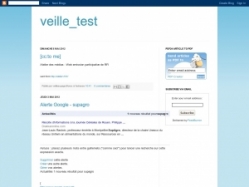
Official website :
http://www.blogger.com
Tool's boxes :
Blogs
Introduction :
Requirements :
- Knowledge of how to use a word processor.
Some practical uses :
Using the tools :
Going further :
Advantages :
- Simple to use for numerous apps: insertion of pictures, editing, opening of several blogs with the same access code, publishing of text, etc.
- Great capacity to personalize the design of your blog.
Drawbacks :
- It is required to configure everything yourself.
Licence :
Proprietary software, Free
Using :
Easy
Setting up :
No setting up
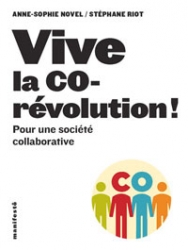
Collaboration in companies: from Coopetition to Collaboration
Card's author :
Hélène Laxenaire - SupAgro Florac
Card's type of licence :
Creative Commons BY-SA
Ideas developped by the author in the field of cooperation within the book or conference :
In their book Long live co-revolution: for a collaborative society, Anne-Sophie Novel and Stéphane Riot describe collaboration between enterprises differentiating coopetition (a portmanteau word : competition+cooperation) from radical collaboration. For two years, they promoted Radical collaboration within the network Entrepreneurs of the future
Long live the co-revolution: for a collaborative society by Anne-Sophie Novel and Stéphane Riot
Introduction: this is not a full review of this work, but a summary of the chapter on Radical collaborationIn their book Long live co-revolution: for a collaborative society, Anne-Sophie Novel and Stéphane Riot describe collaboration between enterprises differentiating coopetition (a portmanteau word : competition+cooperation) from radical collaboration. For two years, they promoted Radical collaboration within the network Entrepreneurs of the future
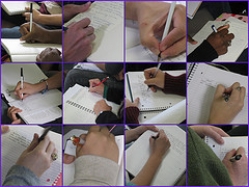
Collaborative writing
Card's author :
Outils-réseaux
Card's type of licence :
Creative Commons BY-SA
Description :
Conceived as a support for building collective knowledge, Web 2.0 has lead to a deep change in the way information is thought of. By freeing writing from the closed universe of printed supports, it has unfolded a whole change in this field. It is now possible for several people to work on a same document at the same time! The enormous success of the Wikipedia, one of the most visited websites in the World, has opened the door to new ways of writing. Defined as a “project for a collectively written free encyclopaedia”, it has proved to what extent collaboration can contribute quality and make a written document so much richer. Richer for the community who benefits from finding different points of view on a same topic. Also richer for the person participating in a project that will lead them to elaborate new writing strategies and to feed on new ideas.
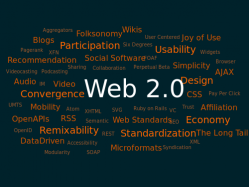
Web 2
Card's author :
Outils-réseaux
Card's type of licence :
Creative Commons BY-SA
Description :
For users, it means more participative tools than can be acquired. For developers, it means formats, standards, technologies eanbling to link systems. In a marketing vision, it covers the notion of services in wich users create contents as well as the economic pattern where free is the rule.
Le Web 2.0
The web 2.0 is a word created in 2004 by Dale Dougherty of the O'Reilly Media corporation and popularized in 2005 by Tim O'Reilly. In an article entitled What is web 2.0 ?, the author redefines the Internet not only as a simple media but as a medium of collective intelligence. A true revolution seating the user in the heart of the Internet and marking for some the return to the fundamentals, for others a vast swindle.For users, it means more participative tools than can be acquired. For developers, it means formats, standards, technologies eanbling to link systems. In a marketing vision, it covers the notion of services in wich users create contents as well as the economic pattern where free is the rule.
Web writing
Card's author :
Outils-réseaux
Card's type of licence :
Creative Commons BY-SA
Description :
Writing for the web : a journalistic writing potentiated by digital technologies
Contrary to a yet too popular belief, one can't write for the web just like that. Apart from an ability shared by journalists to organize and write out information, this exercise needs a good knowledge of the Internet's issues and a methodology peculiar to this tool, actually taking into account that a Netsurfer reads differently the Internet than a newspaper. Care must be taken to get his attention, to guide him, to enable him to come and go easily in the different strata of the site through links and to provide him straight away what he came for : clear, organized and updated data.What we learnt from Cooptic
Hybrid training combining distance and on-site “learning” is an excellent tool for life-long professional development.
However, many conditions are required for this type of training tool to be a real learning ecosystem.
The Cooptic experience has reinforced our convictions regarding certain conditions for training to be successful in the digital era.
Training is no longer a pyramidal transmission of knowledge, where the person that knows passes information down to the person that is learning. It is a co-building of knowledge by networking available information, chosen by the trainers; individual knowledge and experiences that are collectively enriched by reflective exchanges. The training process is rendered explicit by the trainer so that the training provided enables the process of learning to learn.
People are at the centre of the learning process. But these people are easily connected to the world and to others thanks to the new technologies available.
In the training, Cooptic and Animacoop, its French equivalent, we have experienced the construction of learning communities that operate in a similar way to epistemic communities (cf. supra). Trainees publish articles and create training itineraries while gradually becoming active “amateur-experts”. This new quality in people that are training is a real conjunction of intellectual, pedagogical, and even democratic ambitions that really sets the grounds for the pleasure of learning.
The work of trainers changes because it entails several roles in parallel:
- “Expert” trainer: is the reference for the subjects dealt with and transfers knowledge.
- accompanist: is the person that structures and accompanies the group’s progression in a learning environment based on communication and exchange.
- tutor: is the person creating an individualised link with each of the learners helping them to overcome the isolation induced by distance learning.
- "technician": is the person that makes sure that all technical devices work properly.
These new "roles" fulfilled by one or more trainers require deep changes:
- reconsidering “distance” as a space and time with multiple possibilities for interaction and learning. It is possible to learn, create links, work together and produce a resource in multiple ways:
- asynchronous distance contribution based on availability of a space for writing, sharing resources, exchanging via email or a forum,
- synchronous distance during video-conferences or exchanging practices between groups,
- on-site and distance at the same time…it is possible to organise a course on video-conference with two groups in parallel at two different sites.
- making the relationship between trainers, learners and knowledge more horizontal. In the flow of information and exchanges, the trainer is just one element among many others.
- adopting the "surf method "1 ....accepting uncertainties and being brave enough to experiment during the process. Trainers are the ones guaranteeing the methodology: they create the balance conditions and do not necessarily master the form of co-production outcomes.
Innovation elements and the effects they have on the training tool and the cooperative learning
| How Cooptic innovates | The effect on training | The effect on cooperative learning |
| Choosing a wiki as a training platform | Technical device that is easy to use with an intuitive configuration and carefully designed graphics. The trainer tries to minimize any possible technical difficulties. | Reduces difficulties for participation. Generates trust in the tools. Creates a feeling of pleasure. Encourages trainees to publish on the NET. |
| A common space and individual spaces | The wiki platform enables creating personal spaces that are easily linked to a collective support. | Belonging to the learning group is natural (common spaces). Individualised learning is possible (personal space). |
| Open contents | Courses are posted on-line and are accessible to all outside training times. | Freedom to refer to the courses at all times. Greater availability for activities and exchanges. |
| Learning contents that extend beyond those in the courses | Posting the course on-line “frees” time to accompany trainees along the process of acquiring skills. | Knowledge acquisition: "learning to learn" and "learning to work with others". |
| Modular structure | Contents are divided into units (granulated). The general itinerary is defined, but it can be modified during the training. | Building a more personal itinerary is possible. |
| Systematic approach | Contents are selected so they correspond to the activity as a whole, the collaborative network and to the different levels (individual, group, environment). | Acquisition of global perspective. Relatively complete study of the collaborative processes. |
| A multiplicity of structured itineraries | Modular course itineraries (the life of a network). Group activities itinerary (learning community). "professional project” itinerary (collaborative environment). | Multiple opportunities to deal with issues on cooperation and collaboration; put them into practice, facilitate them. Analysis of the collaborative process. |
| Gradual change in the size of work groups | Activities are programmed based on progression: individual exercise, work in pairs, in groups of 4 to 8 | Practice on epistemic communities. Exercise on ephemeral groups (change in scale). |
| Networking and exchanging practices | The activity is conceived as a knowledge aggregator. The trainer provides the methodology. | Valuing experiences as a source of knowledge (reflective practitioner). A particular form of professionalisation (based on the experiences of others). Reinforcing self-esteem. |
| Co-production of contents | An evolutionary platform: everyone can add pages and text. The trainer accompanies the process and ensures it is consistent. | Active stance towards knowledge. The sense of creating a “common good”. |
| Notion of "presence" from a distance | A fine-tuned articulation of distance and on-site times. The effort of accompanying is placed on interaction between participants. “Distance” accompanying is systematized (fixed points with the trainers). | The effect of distance decreases or even transformed. Removing project and culture proximity methods. |
For further information: epistemic communities
Epistemic communities can be defined as a (small) group of representatives who share a common cognitive aim to create knowledge and a common structure that enables a shared understanding. They are heterogeneous groups. Therefore, one of the first tasks for its members is to create a codebook, a form of "code of conduct", defining the aims of the community and the means to achieve these aims, as well as the rules of collective behaviour. Therefore, what distinguishes an epistemic community is, first and foremost, the procedural authority, that ensures progress towards the established aim while allowing participants a certain degree of autonomy.The production of knowledge is done based on the synergy of individual specificities. This requires that the knowledge that flows within the community is made explicit. This is done by converting tacit individual knowledge into explicit and collective knowledge: the members of epistemic communities are united by their responsibilities to value a particular set of different knowledge. The aim of the assessment is therefore related to the individual contribution of effort towards a collective aim that is to be achieved, and the validation of the cognitive activity (production of knowledge) of each member is done by their peers based on the criteria established by the procedural authority. The same applies to the recruitment of new members in this type of groups: it is done by the peers, following the pre-established rules regarding the potential in new members to achieve the community’s aim.
Bibliography
Cohendet, P., Créplet, F. et Dupouët, O., (2003), Innovation organisationnelle, communautés de pratique et communautés épistémiques : le cas de Linux. Revue française de gestion, n° 146, 99-121.
- 1 Rosnay, Joël. Surfer la vie : vers la société fluide. Paris : Les liens qui libèrent, 2012

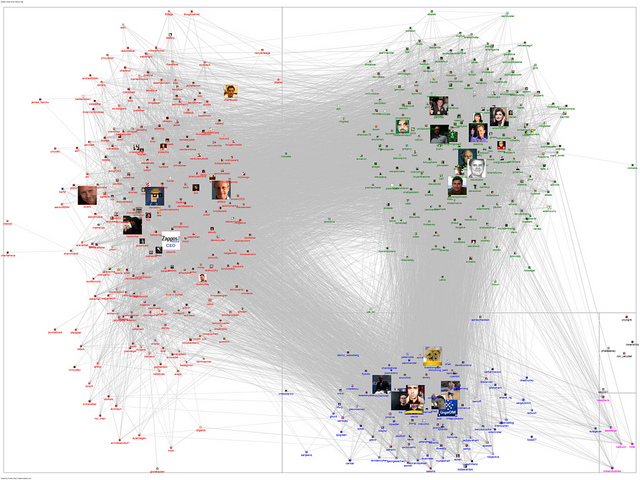
 .
.

